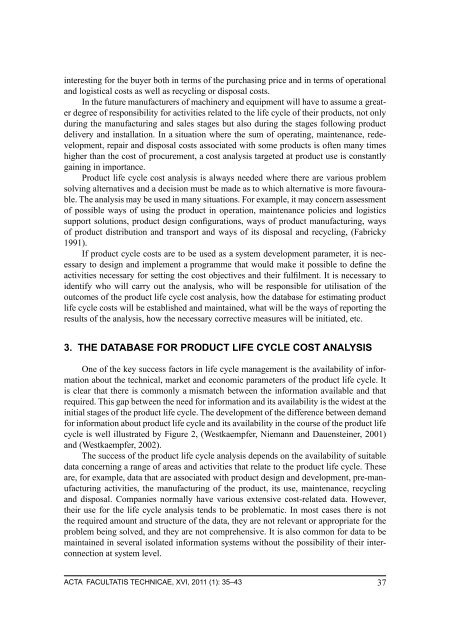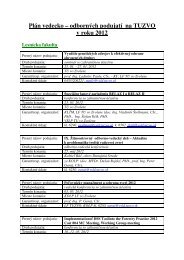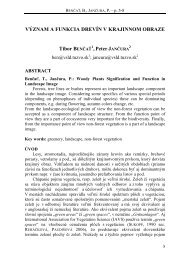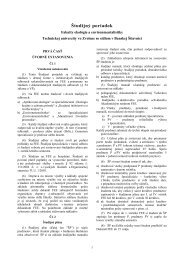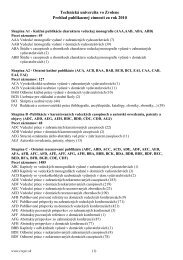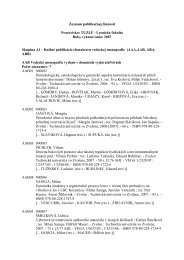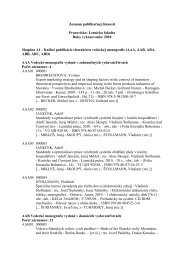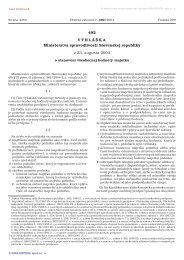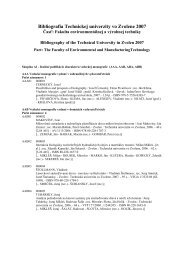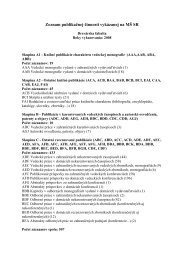product life cycle cost management riadenie nákladov životného ...
product life cycle cost management riadenie nákladov životného ...
product life cycle cost management riadenie nákladov životného ...
You also want an ePaper? Increase the reach of your titles
YUMPU automatically turns print PDFs into web optimized ePapers that Google loves.
interesting for the buyer both in terms of the purchasing price and in terms of operationaland logistical <strong>cost</strong>s as well as recycling or disposal <strong>cost</strong>s.In the future manufacturers of machinery and equipment will have to assume a greaterdegree of responsibility for activities related to the <strong>life</strong> <strong>cycle</strong> of their <strong>product</strong>s, not onlyduring the manufacturing and sales stages but also during the stages following <strong>product</strong>delivery and installation. In a situation where the sum of operating, maintenance, redevelopment,repair and disposal <strong>cost</strong>s associated with some <strong>product</strong>s is often many timeshigher than the <strong>cost</strong> of procurement, a <strong>cost</strong> analysis targeted at <strong>product</strong> use is constantlygaining in importance.Product <strong>life</strong> <strong>cycle</strong> <strong>cost</strong> analysis is always needed where there are various problemsolving alternatives and a decision must be made as to which alternative is more favourable.The analysis may be used in many situations. For example, it may concern assessmentof possible ways of using the <strong>product</strong> in operation, maintenance policies and logisticssupport solutions, <strong>product</strong> design configurations, ways of <strong>product</strong> manufacturing, waysof <strong>product</strong> distribution and transport and ways of its disposal and recycling, (Fabricky1991).If <strong>product</strong> <strong>cycle</strong> <strong>cost</strong>s are to be used as a system development parameter, it is necessaryto design and implement a programme that would make it possible to define theactivities necessary for setting the <strong>cost</strong> objectives and their fulfilment. It is necessary toidentify who will carry out the analysis, who will be responsible for utilisation of theoutcomes of the <strong>product</strong> <strong>life</strong> <strong>cycle</strong> <strong>cost</strong> analysis, how the database for estimating <strong>product</strong><strong>life</strong> <strong>cycle</strong> <strong>cost</strong>s will be established and maintained, what will be the ways of reporting theresults of the analysis, how the necessary corrective measures will be initiated, etc.3. THE DATABASE FOR PRODUCT LIFE CYCLE COST ANALYSISOne of the key success factors in <strong>life</strong> <strong>cycle</strong> <strong>management</strong> is the availability of informationabout the technical, market and economic parameters of the <strong>product</strong> <strong>life</strong> <strong>cycle</strong>. Itis clear that there is commonly a mismatch between the information available and thatrequired. This gap between the need for information and its availability is the widest at theinitial stages of the <strong>product</strong> <strong>life</strong> <strong>cycle</strong>. The development of the difference between demandfor information about <strong>product</strong> <strong>life</strong> <strong>cycle</strong> and its availability in the course of the <strong>product</strong> <strong>life</strong><strong>cycle</strong> is well illustrated by Figure 2, (Westkaempfer, Niemann and Dauensteiner, 2001)and (Westkaempfer, 2002).The success of the <strong>product</strong> <strong>life</strong> <strong>cycle</strong> analysis depends on the availability of suitabledata concerning a range of areas and activities that relate to the <strong>product</strong> <strong>life</strong> <strong>cycle</strong>. Theseare, for example, data that are associated with <strong>product</strong> design and development, pre-manufacturingactivities, the manufacturing of the <strong>product</strong>, its use, maintenance, recyclingand disposal. Companies normally have various extensive <strong>cost</strong>-related data. However,their use for the <strong>life</strong> <strong>cycle</strong> analysis tends to be problematic. In most cases there is notthe required amount and structure of the data, they are not relevant or appropriate for theproblem being solved, and they are not comprehensive. It is also common for data to bemaintained in several isolated information systems without the possibility of their interconnectionat system level.ACTA FACULTATIS TECHNICAE, XVI, 2011 (1): 35–4337


